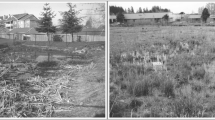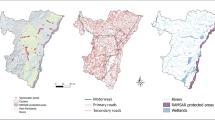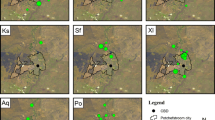Abstract
Stormwater retention ponds in urbanizing catchments are constructed to collect and treat runoff from impervious surfaces. Amphibians often inhabit retention ponds, which may partly offset the loss of natural wetlands resulting from urbanization. We investigated the use of retention ponds by frogs in a rapidly-urbanizing region of south-eastern Australia to (1) determine the habitat attributes associated with individual species, and (2) recommend specific wetland design criteria to enhance populations of frog species in the region and in other urbanizing areas throughout their distribution. We detected nine species of frogs during calling surveys at 30 retention pond sites in Greater Melbourne, 2008–2010. There were contrasting differences in habitat associations among five species for which we produced regression models of abundance or occurrence. The mean abundance of Crinia signifera increased with site area, whereas Limnodynastes dumerilii was associated with smaller sites. The occurrence of L. dumerilii was positively associated with waterbody shore depth, whereas L. peronii and L. tasmaniensis were associated with shallow shores. Two species were positively associated with time since construction or since dredging of a site, whereas the occurrence of L. dumerilii decreased with site age. Aquatic vegetation at a site was important for the occurrence of L. peronii and Litoria ewingii. There was evidence for a positive effect of aquatic connectivity on the occurrence of Limnodynastes peronii, which emphasizes the importance of riparian corridors in urban settings. These results highlight the contrasting differences in habitat associations among species in the region. We recommend that retention ponds in our region and elsewhere be constructed or enhanced to include specific habitat attributes that were found to be associated with different amphibian species. We recommend long-term monitoring at sites to determine whether retention ponds augment existing frog populations or contribute to declines.






Similar content being viewed by others
References
Alberti M, Booth D, Hill K, Coburn B, Avolio C, Coe S, Spirandelli D (2007) The impact of urban patterns on aquatic ecosystems: an empirical analysis in Puget lowland sub-basins. Landscape Urban Plann 80:345–361
Anstis M (2002) Tadpoles of south-eastern Australia: a guide with keys. Reed New Holland, Sydney
Aresco MJ, Gunzburger MS (2004) Effects of large-scale sediment removal on herpetofauna in Florida wetlands. J Herpetol 38:275–279
Australian Bureau of Statistics (2010) Year Book Australia, 2009–10. No. 91, Australian Bureau of Statistics, Canberra, Australia
Awal S, Svozil D (2010) Macro-invertebrate species diversity as a potential universal measure of wetland ecosystem integrity in constructed wetlands in South East Melbourne. Aquat Ecosyst Health Manage 13:472–479
Battin J (2004) When good animals love bad habitats: ecological traps and the conservation of animal populations. Conserv Biol 18:1482–1491
Birx-Raybuck DA, Price SJ, Dorcas ME (2010) Pond age and riparian zone proximity influence anuran occupancy of urban retention ponds. Urban Ecosyst 13:181–190
Bishop CA, Struger J, Shirose LJ, Dunn L, Campbell GD (2000a) Contamination and wildlife communities in stormwater detention ponds in Guelph and the Greater Toronto Area, Ontario, 1997 and 1998. Part II – contamination and biological effects of contamination. Water Qual Res J Canada 35:437–474
Bishop CA, Struger J, Barton DR, Shirose LJ, Dunn L, Lang AL, Shepherd D (2000b) Contamination and wildlife communities in stormwater detention ponds in Guelph and the Greater Toronto Area, Ontario, 1997 and 1998. Part I – wildlife communities. Water Qual Res J Canada 35:399–435
Brand AB, Snodgrass JW (2010) Value of artificial habitats for amphibian reproduction in altered landscapes. Conserv Biol 24:295–301
Brand AB, Snodgrass JW, Gallagher MT, Casey RE, Van Meter R (2010) Lethal and sublethal effects of embryonic and larval exposure of Hyla versicolor to stormwater pond sediments. Arch Environ Contam Toxicol 58:325–331
Burnham KP, Anderson DR (2002) Model selection and inference: a practical information-theoretic approach, 2nd edn. Springer, New York
Casey RE, Shaw AN, Massal LR, Snodgrass JW (2005) Multimedia evaluation of trace metal distribution within stormwater retention ponds in suburban Maryland, USA. Bull Environ Contam Toxicol 74:273–280
Cook RP, Tupper TA, Paton PWC, Timm BC (2011) Effects of temperature and temporal factors on anuran detection probabilities at Cape Cod National Seashore, Massachusetts, USA: Implications for long-term monitoring. Herpetol Conserv Biol 6:25–39
Department of Sustainability and Environment (2006) Watercourse Network 1:25,000 - Vicmap Hydro (ArcView Shapefile: HY_WATERCOURSE/). Department of Sustainability and Environment, Melbourne
Dorcas ME, Price SJ, Walls SC, Barichivich WJ (2010) Auditory monitoring of anuran populations. In: Dodd CK (ed) Amphibian ecology and conservation: a handbook of techniques. Oxford University Press, Oxford, pp 281–298
Ehrenfeld JG (2000) Evaluating wetlands within an urban context. Ecol Eng 15:253–265
Ficetola GF, Padoa-Schioppa E, De Bernardi F (2009) Influence of landscape elements in riparian buffers on the conservation of semiaquatic amphibians. Conserv Biol 23:114–123
Gagné SA, Fahrig L (2010) Effects of time since urbanization on anuran community composition in remnant urban ponds. Environ Conserv 37:128–135
Hamer AJ, McDonnell MJ (2008) Amphibian ecology and conservation in the urbanising world: a review. Biol Conserv 141:2432–2449
Hamer AJ, McDonnell MJ (2010) The response of herpetofauna to urbanization: inferring patterns of persistence from wildlife databases. Austral Ecol 35:568–580
Hamer AJ, Parris KM (2011) Local and landscape determinants of amphibian communities in urban ponds. Ecol Appl 21:378–390
Harrell FE, Lee KL, Mark DB (1996) Multivariate prognostic models: issues in developing models, evaluating assumptions and adequacy, and measuring and reducing errors. Stat Med 15:361–387
Hazell D, Cunningham R, Lindenmayer D, Mackey B, Osborne W (2001) Use of farm dams as frog habitat in an Australian agricultural landscape: factors affecting species richness and distribution. Biol Conserv 102:155–169
Helfield JM, Diamond ML (1997) Use of constructed wetlands for urban stream restoration: a critical analysis. Environ Manage 21:329–341
Hero J-M, Littlejohn M, Marantelli G (1991) Frogwatch field guide to Victorian frogs. Department of Conservation and Environment, East Melbourne
Hines JE (2006) PRESENCE2- Software to estimate patch occupancy and related parameters. USGS-PWRC. http://www.mbr-pwrc.usgs.gov/software/presence.html
Kentula ME, Gwin SE, Pierson SM (2004) Tracking changes in wetlands with urbanization: sixteen years of experience in Portland, Oregon, USA. Wetlands 24:734–743
Kéry M (2002) Inferring the absence of a species – a case study of snakes. J Wildl Manage 66:330–338
Lee SY, Dunn RJK, Young RA, Connolly RM, Dale PER, Dehayr R et al (2006) Impact of urbanization on coastal wetland structure and function. Austral Ecol 31:149–163
Lloyd SD, Wong THF, Porter B (2002) The planning and construction of an urban stormwater management scheme. Water Sci Technol 45:1–10
Löfvenhaft K, Runborg S, Sjögren-Gulve P (2004) Biotope patterns and amphibian distribution as assessment tools in urban landscape planning. Landscape Urban Plann 68:403–427
MacKenzie DI, Nichols JD, Lachman GB, Droege S, Royle JA, Langtimm CA (2002) Estimating site occupancy rates when detection probabilities are less than one. Ecology 83:2248–2255
Massal LR, Snodgrass JW, Casey RE (2007) Nitrogen pollution of stormwater ponds: potential for toxic effects on amphibian embryos and larvae. Appl Herpetol 4:19–29
Mazerolle MJ, Bailey LL, Kendall WL, Royle JA, Converse SJ, Nichols JD (2007) Making great leaps forward: accounting for detectability in herpetological field studies. J Herpetol 41:672–689
McCarthy MA (2007) Bayesian methods for ecology. Cambridge University Press, Cambridge
McCarthy K, Lathrop RG (2011) Stormwater basins of the New Jersey coastal plain: subsidies or sinks for frogs and toads? Urban Ecosyst 14:395–413
Melbourne Water (2005) Constructed wetland systems: design guidelines for developers. Version 3, Melbourne Water, Melbourne, Australia. http://www.melbournewater.com.au/content/library/wsud/melbourne_water_wetland_design_guide.pdf
Meyer JL, Paul MJ, Taulbee WK (2005) Stream ecosystem function in urbanizing landscapes. J North Amer Benthol Soc 24:602–612
Miltner RJ, White D, Yoder C (2004) The biotic integrity of streams in urban and suburbanizing landscapes. Landscape Urban Plann 69:87–100
Ostergaard EC, Richter KO, West SD (2008) Amphibian use of stormwater ponds in the Puget Lowlands of Washington, USA. In: Mitchell JC, Jung Brown RE, Bartholomew B (eds) Urban herpetology. Herpetological Conservation No. 3, Society for the Study of Amphibians and Reptiles. Salt Lake City, USA, pp 259–270
Parris KM (2006) Urban amphibian assemblages as metacommunities. J Anim Ecol 75:757–764
Parris KM, Lindenmayer DB (2004) Evidence that creation of a Pinus radiata plantation in south-eastern Australia has reduced habitat for frogs. Acta Oecol 25:93–101
Paul MJ, Meyer JL (2001) Streams in the urban landscape. Annu Rev Ecol Syst 32:333–365
Pellet J, Schmidt BR (2005) Monitoring distributions using call surveys: estimating site occupancy, detection probabilities and inferring absence. Biol Conserv 123:27–35
Porej D, Hetherington TE (2005) Designing wetlands for amphibians: the importance of predatory fish and shallow littoral zones in structuring of amphibian communities. Wetl Ecol Manag 13:445–455
Rannap R, Lõhmus A, Briggs L (2009) Restoring ponds for amphibians: a success story. Hydrobiologia 634:87–95
Reinelt L, Horner R, Azous A (1998) Impacts of urbanization on palustrine (depressional freshwater) wetlands - research and management in the Puget Sound region. Urban Ecosyst 2:219–236
Ruiz AM, Maerz JC, Davis AK, Keel MK, Ferreira AR, Conroy MJ et al (2010) Patterns of development and abnormalities among tadpoles in a constructed wetland receiving treated wastewater. Environ Sci Technol 44:4862–4868
Scher O, Thièry A (2005) Odonata, Amphibia and environmental characteristics in motorway stormwater retention ponds (Southern France). Hydrobiologia 551:237–251
Scott NJ, Woodward BD (1994) Surveys at breeding sites. In: Heyer WR, Donnelly MA, McDiarmid RW, Hayek LC, Foster MS (eds) Measuring and monitoring biological diversity. Standard methods for amphibians. Smithsonian Institution Press, Washington, pp 118–125
Semlitsch RD (2002) Critical elements for biologically based recovery plans of aquatic-breeding amphibians. Conserv Biol 16:619–629
Semlitsch RD, Bodie JR (1998) Are small, isolated wetlands expendable? Conserv Biol 12:1129–1133
Semlitsch RD, Bodie JR (2003) Biological criteria for buffer zones around wetlands and riparian habitats for amphibians and reptiles. Conserv Biol 17:1219–1228
Shulse CD, Semlitsch RD, Trauth KM, Williams AD (2010) Influences of design and landscape placement parameters on amphibian abundance in constructed wetlands. Wetlands 30:915–928
Simon JA, Snodgrass JW, Casey RE, Sparling DW (2009) Spatial correlates of amphibian use of constructed wetlands in an urban landscape. Landscape Ecol 24:361–373
Snodgrass JW, Casey RE, Joseph D, Simon JA (2008) Microcosm investigations of stormwater pond sediment toxicity to embryonic and larval amphibians: variation in sensitivity among species. Environ Pollut 154:291–297
Spiegelhalter DJ, Best NG, Carlin BP, van der Linde A (2002) Bayesian measures of model complexity and fit. J R Statist Soc B 64:583–639
Spiegelhalter D, Thomas A, Best N, Lunn D (2007) OpenBUGS user manual. Version 3.0.2. MRC Biostatistics Unit, Cambridge, United Kingdom
Steelman CK, Dorcas ME (2010) Anuran calling survey optimization: developing and testing predictive models of anuran calling activity. J Herpetol 44:61–68
Stern H (2005) Climate. In: Brown-May A, Swain S (eds) The encyclopedia of Melbourne. Cambridge University Press, Melbourne, pp 147–154
Stratman D (2000) Using micro and macrotopography in wetland restoration. Indiana Biology Technical Note No. 1, US Department of Agriculture, Natural Resources Conservation Service, Indianapolis, USA
Tilton DL (1995) Integrating wetlands into planned landscapes. Landscape Urban Plann 32:205–209
Victorian Stormwater Committee (1999) Urban stormwater: best practice environmental management guidelines. CSIRO Publishing, Collingwood
Walsh CJ, Sharpe AK, Breen PF, Sonneman JA (2001) Effects of urbanization on streams of the Melbourne region, Victoria, Australia. I. Benthic macroinvertebrate communities. Freshw Biol 46:535–551
Walsh CJ, Roy AH, Feminella JW, Cottingham PD, Groffman PM, Morgan RP (2005) The urban stream syndrome: current knowledge and the search for a cure. J North Amer Benthol Soc 24:706–723
Weir LA, Royle JA, Nanjappa P, Jung RE (2005) Modeling anuran detection and site occupancy on North American Amphibian Monitoring Program (NAAMP) routes in Maryland. J Herpetol 39:627–639
Acknowledgements
We thank staff at Melbourne Water for arranging access to sites and data: William Steele, Rhys Coleman and Lucy Rose. Julia Stammers provided valuable assistance improving the quality of the paper. The Baker Foundation provided generous support for this research. This study was approved by the University of Melbourne Animal Ethics Committee (register no. 0706488). Fieldwork was conducted under research permit no. 10004319 issued by the Victorian Department of Sustainability and Environment.
Author information
Authors and Affiliations
Corresponding author
Rights and permissions
About this article
Cite this article
Hamer, A.J., Smith, P.J. & McDonnell, M.J. The importance of habitat design and aquatic connectivity in amphibian use of urban stormwater retention ponds. Urban Ecosyst 15, 451–471 (2012). https://doi.org/10.1007/s11252-011-0212-5
Published:
Issue Date:
DOI: https://doi.org/10.1007/s11252-011-0212-5




